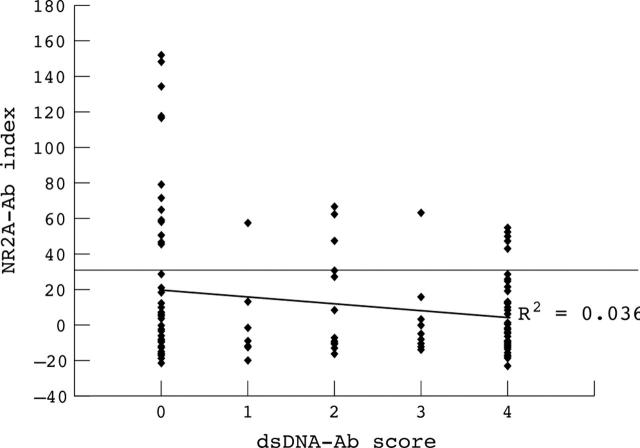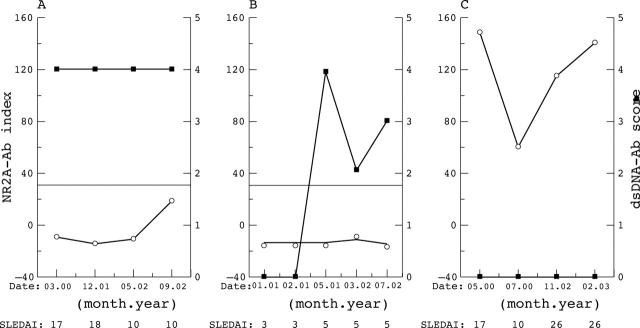Abstract
Objective: To determine the prevalence of autoantibodies directed against an epitope of the glutamate/N-methyl-D-aspartic acid (NMDA) receptor subunit NR2A (which is highly expressed in human brain) in the sera of lupus patients, and to investigate the possible correlation of these antibodies with clinical and serological manifestations of systemic lupus erythematosus (SLE).
Methods: Sera were obtained from 109 consecutive SLE patients. Controls were 65 patients with myasthenia gravis, 19 with autoimmune polyendocrine syndrome type I (APS I), and 65 healthy donors. A 15 amino acid long peptide based on a sequence within the NR2A subunit of the NMDA/glutamate receptor was synthesised. Antibodies to this peptide were determined by enzyme linked immunosorbent assay. Antibodies against double stranded DNA (dsDNA) were measured by Chrithidia luciliae assay. Disease activity was determined using the SLE disease activity index (SLEDAI).
Results: Sera of 34/109 SLE patients (31%) reacted specifically with the NR2A peptide compared with only 4/65 myasthenia gravis patients (6.1%, p<0.001), 1/19 APS I patients (5.3%, p<0.02), and 3/65 healthy controls (4.6%, p<0.001). No correlation was found between the presence of NR2A and dsDNA or anti-cardiolipin specific autoantibodies. In addition, no significant correlation was observed between the presence of NR2A specific antibodies and the SLEDAI score or any lupus related clinical manifestations.
Conclusions: A significant number of SLE patients (31%) have NR2A specific antibodies that do not correlate with anti-dsDNA antibodies. Additional studies of lupus patients with neurological disorders should elucidate the role of NR2A specific antibodies in lupus related CNS manifestations.
Full Text
The Full Text of this article is available as a PDF (86.4 KB).
Figure 1.
Antibodies against the NR2A peptide of the glutamate/NMDA receptor in sera of patients with systemic lupus erythematosus (SLE). Sera from 109 SLE patients, 65 patients with myasthenia gravis (MG), 19 patients with autoimmune polyendocrine syndrome type I (APS1), and 65 healthy controls were tested. NR2A specific antibodies were determined by enzyme linked immunosorbent assay (ELISA). Results are expressed as NR2A antibody indices, calculated as described in Methods. The horizontal line represents the upper normal limit (NR2A antibody index of 30) defined as the mean of 65 normal controls +2SD. *p<0.001, **p<0.02.
Figure 2.
Correlation between NR2A antibody indices and dsDNA reactivity in sera of patients with systemic lupus erythematosus (SLE). The NR2A antibody indices and dsDNA antibody reactivity (negative to +4) were compared in 125 serum samples from 59 SLE patients (two or more serum samples per patient). The line represents the linear regression. dsDNA, double stranded deoxyribonucleic acid.
Figure 3.
Correlation between NR2A antibody indices, dsDNA specific antibodies, and systemic lupus erythematosus disease activity index (SLEDAI). NR2A antibody index, dsDNA reactivity, and SLEDAI were determined in three different SLE patients (A, B, C) during a follow up period of 18 to 33 months. dsDNA, double stranded deoxyribonucleic acid.
Selected References
These references are in PubMed. This may not be the complete list of references from this article.
- Ainiala H., Loukkola J., Peltola J., Korpela M., Hietaharju A. The prevalence of neuropsychiatric syndromes in systemic lupus erythematosus. Neurology. 2001 Aug 14;57(3):496–500. doi: 10.1212/wnl.57.3.496. [DOI] [PubMed] [Google Scholar]
- Arbuckle Melissa R., McClain Micah T., Rubertone Mark V., Scofield R. Hal, Dennis Gregory J., James Judith A., Harley John B. Development of autoantibodies before the clinical onset of systemic lupus erythematosus. N Engl J Med. 2003 Oct 16;349(16):1526–1533. doi: 10.1056/NEJMoa021933. [DOI] [PubMed] [Google Scholar]
- Bombardier C., Gladman D. D., Urowitz M. B., Caron D., Chang C. H. Derivation of the SLEDAI. A disease activity index for lupus patients. The Committee on Prognosis Studies in SLE. Arthritis Rheum. 1992 Jun;35(6):630–640. doi: 10.1002/art.1780350606. [DOI] [PubMed] [Google Scholar]
- Choi D. W., Rothman S. M. The role of glutamate neurotoxicity in hypoxic-ischemic neuronal death. Annu Rev Neurosci. 1990;13:171–182. doi: 10.1146/annurev.ne.13.030190.001131. [DOI] [PubMed] [Google Scholar]
- Dambinova Svetlana A., Khounteev Guerman A., Izykenova Galina A., Zavolokov Igor G., Ilyukhina Anna Y., Skoromets Alexander A. Blood test detecting autoantibodies to N-methyl-D-aspartate neuroreceptors for evaluation of patients with transient ischemic attack and stroke. Clin Chem. 2003 Oct;49(10):1752–1762. doi: 10.1373/49.10.1752. [DOI] [PubMed] [Google Scholar]
- DeGiorgio L. A., Konstantinov K. N., Lee S. C., Hardin J. A., Volpe B. T., Diamond B. A subset of lupus anti-DNA antibodies cross-reacts with the NR2 glutamate receptor in systemic lupus erythematosus. Nat Med. 2001 Nov;7(11):1189–1193. doi: 10.1038/nm1101-1189. [DOI] [PubMed] [Google Scholar]
- Kurki P., Helve T., Dahl D., Virtanen I. Neurofilament antibodies in systemic lupus erythematosus. J Rheumatol. 1986 Feb;13(1):69–73. [PubMed] [Google Scholar]
- Lefkowith J. B., Gilkeson G. S. Nephritogenic autoantibodies in lupus: current concepts and continuing controversies. Arthritis Rheum. 1996 Jun;39(6):894–903. doi: 10.1002/art.1780390605. [DOI] [PubMed] [Google Scholar]
- Loukkola Jukka, Laine Matti, Ainiala Hanna, Peltola Jukka, Metsänoja Riina, Auvinen Anssi, Hietaharju Aki. Cognitive impairment in systemic lupus erythematosus and neuropsychiatric systemic lupus erythematosus: a population-based neuropsychological study. J Clin Exp Neuropsychol. 2003 Feb;25(1):145–151. doi: 10.1076/jcen.25.1.145.13621. [DOI] [PubMed] [Google Scholar]
- Mattson M. P., LaFerla F. M., Chan S. L., Leissring M. A., Shepel P. N., Geiger J. D. Calcium signaling in the ER: its role in neuronal plasticity and neurodegenerative disorders. Trends Neurosci. 2000 May;23(5):222–229. doi: 10.1016/s0166-2236(00)01548-4. [DOI] [PubMed] [Google Scholar]
- Mayer Mark L., Armstrong Neali. Structure and function of glutamate receptor ion channels. Annu Rev Physiol. 2004;66:161–181. doi: 10.1146/annurev.physiol.66.050802.084104. [DOI] [PubMed] [Google Scholar]
- Morris R. G., Anderson E., Lynch G. S., Baudry M. Selective impairment of learning and blockade of long-term potentiation by an N-methyl-D-aspartate receptor antagonist, AP5. 1986 Feb 27-Mar 5Nature. 319(6056):774–776. doi: 10.1038/319774a0. [DOI] [PubMed] [Google Scholar]
- Reichlin M. Ribosomal P antibodies and CNS lupus. Lupus. 2003;12(12):916–918. doi: 10.1191/0961203303lu502oa. [DOI] [PubMed] [Google Scholar]
- Sanna Giovanni, Bertolaccini Maria L., Cuadrado Maria J., Laing Hana, Khamashta Munther A., Mathieu Alessandro, Hughes Graham R. V. Neuropsychiatric manifestations in systemic lupus erythematosus: prevalence and association with antiphospholipid antibodies. J Rheumatol. 2003 May;30(5):985–992. [PubMed] [Google Scholar]
- Scatton B. The NMDA receptor complex. Fundam Clin Pharmacol. 1993;7(8):389–400. doi: 10.1111/j.1472-8206.1993.tb01036.x. [DOI] [PubMed] [Google Scholar]
- Schnölzer M., Kent S. B. Constructing proteins by dovetailing unprotected synthetic peptides: backbone-engineered HIV protease. Science. 1992 Apr 10;256(5054):221–225. doi: 10.1126/science.1566069. [DOI] [PubMed] [Google Scholar]
- Skerry T. M., Genever P. G. Glutamate signalling in non-neuronal tissues. Trends Pharmacol Sci. 2001 Apr;22(4):174–181. doi: 10.1016/s0165-6147(00)01642-4. [DOI] [PubMed] [Google Scholar]
- Sthoeger Z. M., Tartakovsky B., Bentwich Z., Mozes E. Monoclonal anticardiolipin antibodies derived from mice with experimental lupus erythematosus: characterization and the induction of a secondary antiphospholipid syndrome. J Clin Immunol. 1993 Mar;13(2):127–138. doi: 10.1007/BF00919269. [DOI] [PubMed] [Google Scholar]
- Takahashi Y., Mori H., Mishina M., Watanabe M., Fujiwara T., Shimomura J., Aiba H., Miyajima T., Saito Y., Nezu A. Autoantibodies to NMDA receptor in patients with chronic forms of epilepsia partialis continua. Neurology. 2003 Oct 14;61(7):891–896. doi: 10.1212/01.wnl.0000086819.53078.70. [DOI] [PubMed] [Google Scholar]
- Tan E. M. Autoantibodies to nuclear antigens (ANA): their immunobiology and medicine. Adv Immunol. 1982;33:167–240. doi: 10.1016/s0065-2776(08)60836-6. [DOI] [PubMed] [Google Scholar]
- Tan E. M., Cohen A. S., Fries J. F., Masi A. T., McShane D. J., Rothfield N. F., Schaller J. G., Talal N., Winchester R. J. The 1982 revised criteria for the classification of systemic lupus erythematosus. Arthritis Rheum. 1982 Nov;25(11):1271–1277. doi: 10.1002/art.1780251101. [DOI] [PubMed] [Google Scholar]
- Williams Ralph C., Jr, Sugiura Kazumitsu, Tan Eng M. Antibodies to microtubule-associated protein 2 in patients with neuropsychiatric systemic lupus erythematosus. Arthritis Rheum. 2004 Apr;50(4):1239–1247. doi: 10.1002/art.20156. [DOI] [PubMed] [Google Scholar]





